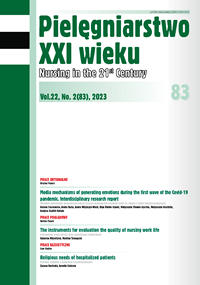Religious needs of hospitalized patients
DOI:
https://doi.org/10.2478/pielxxiw-2023-0015Keywords:
religious needs, patients, nursingAbstract
RELIGIOUS NEEDS OF HOSPITALIZED PATIENTS
Introduction. Meeting the religious needs of hospitalized patients is an essential part of nursing care. Their timely identification by nurses and subsequent satisfaction may lead to an easier adaptation to the hospital environment and illness, and contribute to the overall comfort of the patients.
Aim. The aim of the study was to determine the religiosity of selected hospitalized patients in the premorbid and morbid period and the participation of nurses in meeting religious needs.
Material and methods. To achieve the goals, we chose a qualitative method – a case study. A Spiritual Screening Tool for Older Adults and a questionnaire by Canda and Furman were used to assess spirituality and religiosity implicitly and explicitly. The respondent sample consisted of three patients hospitalized in inpatient wards of medical facilities with diff erent gender, diagnoses and duration of the disease.
Results. According to Spiritual Screening Tool for Older Adults, we found positive spiritual health in patients A, M and R. Religious needs during hospitalization were partially satisfied in patient A and fully satisfied in patients M and R, but only through individual activities (prayer, visiting the hospital chapel and others). None of the patients had their needs met by nurses.
Conclusions. We recommend using the tools aimed at assessing patients’ religiosity and continue with the planning and implementation of nursing interventions accordingly. Active cooperattion with “spiritual assistants” and integrating the issue of religious needs into the content of education of future nurses are also recommended.
References
1. Oxhandler HK, Parrish DE. Integrating clients’ religion/spirituality in clinical practice: A comparison among social workers, psychologists, counselors, marriage and family therapists, and nurses. J. Clin. Psychol. 2018; 74(4): 680-694.
2. Puchalski CHM. Religion, Medicine and Spirituality: What We Know, What We Don’t Know and What We Do. Asian. Pacifi c J. Cancer Prev. 2010; 11, MECC Supplement, 45-49.
3. Saroglou V, et al. Believing, Bonding, Behaving, and Belonging: The Cognitive, Emotional, Moral and Social Dimensions of Religiousness across Cultures. Journal of Cross-Cultural Psychology. 2020; 51(7-8): 551-575.
4. Velez FJR. Spiritual care of the sick. Linacre Q. 2017; 84(3): 220-225.
5. Timmins F, et al. The role of the healthcare chaplain: A literature review. J. Health Care Chaplain. 2018; 24(3): 87-106.
6. Sharma V, et al. The Diff erential Eff ects of Chaplain Interventions on Patient Satisfaction. J. Health Care Chaplain. 2016; 22(3): 85-101.
7. Cervelin AF, Kruse MHL. Spirituality and religiosity in palliative care: learning to govern. Esc Anna Nery. 2014; 18(1): 136-142.
8. Ahmadi Z, et al. The eff ects of spirituality and religiosity on well-being of people with cancer: A literature review on current evidences. Jundishapur. Journal of Chronic Disease Care. 2015; 4(2): e28386.
9. Swihart DL, et al. Cultural religious competence in clinical practice. Stat Pearls [Internet]. 2022.
10. Andersen AH, et al. Doctor–patient communication about existential, spiritual and religious needs in chronic pain: A systematic review. Archive for the Psychology of Religion. 2019; 41(3): 277-299.
11. Canda E, Furman LD. Spiritual Diversity in Social Work Practice. The Heart of Helping. New York: Oxford University Press; 2010. 472 p.
12. Stranahan S. A Spiritual Screening Tool for Older Adults. J. Relig. Health. 2008; 47(4): 491-503.
13. Herdman HT, Kamitsuru S, Lopes TC. NANDA International Nursing Diagnoses: Defi nitions and Classifi cation, 2021-2023. New York: Thieme Medical Publishers; 2021, p. 592.
14. Andrasi I. Spiritualne potreby pacientov v paliativnej starostlivosti. Martin: Osveta; 2015, p. 122.
15. Dein S. Religious healing and mental health. Mental Health, Religion & Culture. 2020; 23(8): 657-665.
16. Koening H, King G, Carson VB. Handbook of Religion and Health. New York: Oxford University press; 2012, p. 1192.
17. Crize LB, et al. Espiritualidade no cuidado de enfermagem ao paciente oncologicoem cuidados paliativos. Salusvita Bauru. 2018; 37(3): 577-597.
18. Thiengo PC, et al. Spirituality and religiosity in health care: an integrative review. Cogitare enferm. 2019; 24: e58692.
19. Areshtanab H, et al. Health care providers’ perception of their competence in providing spiritual care for patients. Indian Journal of Palliative Care. 2017; 23(1): 57.
20. Kiaei MZ, et al. Spirituality and spiritual care in Iran: nurses’ perceptions and barriers. International Nursing Review. 2015, 62(4): 584-592.
21. Austin PD, et al. The ability of hospital staff to recognise and meet patients’ spiritual needs: a pilot study. Journal for the Study of Spirituality. 2016; 6(1): 20-37.
22. Kanwal N, et al. Assess spirituality and spiritual care in nursing practice in Public Hospital Lahore. Saudi Journal of Medical and Pharmaceutical Sciences. 2017; 3(6B): 596-607.
23. Deluga A, et. al. Selected determinants of spirituality among nurses. Pielęgniarstwo XXI wieku. 2021; 20(1): 22-29.
24. Connerton CHS, Moe CS. The Essence of Spiritual Care. Creat. Nurs. 2018; 24(1): 36-41.
25. Holloway M. Spiritual need and the core business of social work. British Journal of Social Work. 2007; 37(2): 265-280.
Downloads
Published
Issue
Section
License
Copyright (c) 2023 Authors

This work is licensed under a Creative Commons Attribution 4.0 International License.




